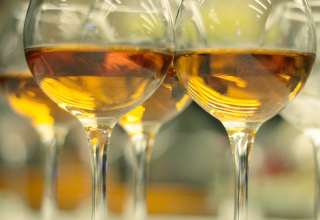We’ve all been there. You’re gasping for a glass of cold white wine, but the bottle is at room temperature. Here’s the best way to chill that Sauvignon Blanc in record time?
 The first thing you think of when picking up a glass of luke warm white wine is to turn to the freezer and grab a couple of cubes of ice. Well think again. By doing so you are not only be committing the ultimate drinks faux pas, but are, in the process watering, and, in effect, ruining your glass of wine.
The first thing you think of when picking up a glass of luke warm white wine is to turn to the freezer and grab a couple of cubes of ice. Well think again. By doing so you are not only be committing the ultimate drinks faux pas, but are, in the process watering, and, in effect, ruining your glass of wine.
And you’d have to face the likely opprobrium of your wine waiter too. According to drinks bible Decanter magazine, putting ice cubes into white wine was often cited as “the most annoying customer habit” amongst sommeliers.
Wines with ice
However, several wineries have launched wines, Champagnes even, in recent months which are specifically intended to be served chilled with ice, including the Moet Ice Imperial Rose. So if it’s good enough for Moet…
Peter Richards, a master of wine, believes we should all be much more relaxed about the whole thing. “Do what you want with your wine as long as it makes you happy,” he says. Before adding a slight warning: “But unless you’re drinking super fast, the ice will melt and dilute the wine and it won’t taste as good.”
 Add frozen grapes
Add frozen grapes
An alternative way to chill your wine, without sacrificing the flavour is to put a few grapes in the freezer, and then pop them into your wine glass. This will have the effect of chilling the wine without diluting it. You could also use strawberries or other fruits to add a touch of favour to the wine as well, particularly rosé.
Wine chillers
If you are really in a hurry and want to chill a whole bottle of wine fast, then one of the best ways is by using a special wine chiller which you keep in the freezer, and then wrap around the bottle when required.
There are other types of wine chillers available, including a kind of icicle stick that you also keep in the freezer, then put inside the bottle to cool the contents.
Chilling red wine
It might sound even worse than throwing ice in your white wine, but it is actually quite OK, and well used practice by leading restaurants and sommeliers to chill red wine, particularly in hot climates or temperatures. Most red wines taste best at certain key temperatures, but there are some styles, notably lighter, fresher reds than can be just as good, if not better, when chilled.
Which is why you will often see a sommelier wipe the condensation from a bottle of red wine as he serves it at your table as it may have come straight from a carefully controlled fridge.
Freezing wine
 Freezing wine is not recommended. Most wines will begin to freeze at around -6 degrees centigrade, and the higher the alcohol content the lower the freezing point. If ice forms in the bottle, the pressure through expansion will push the cork out of the neck of the bottle, which in extreme cases could break the hermetic seal, causing leakage and allowing air in which will cause oxidation in the wine and make it undrinkable. So best to put the alarm on if you pop your wine in the freezer for an instant chill.
Freezing wine is not recommended. Most wines will begin to freeze at around -6 degrees centigrade, and the higher the alcohol content the lower the freezing point. If ice forms in the bottle, the pressure through expansion will push the cork out of the neck of the bottle, which in extreme cases could break the hermetic seal, causing leakage and allowing air in which will cause oxidation in the wine and make it undrinkable. So best to put the alarm on if you pop your wine in the freezer for an instant chill.
Wine diamonds
If you do accidentally freeze a bottle of wine, the chances are that once its defrosted, providing the cork is still intact, that it will be perfectly drinkable. But sometimes freezing causes a visible change in the wine in the form of potassium tartrate crystals. These “wine diamonds” as they are known, resemble little shards of glass, but are perfectly harmless. The crystals will usually drop to the bottom of the bottle, but occasionally a few will stick to the surface of the cork.
But never put sparkling wine or Champagne in the freezer unless you want to deal with the aftermath of a messy explosion.
Fetch for the salt
Instead, to cool a bottle of wine or bubbly quickly then how about this tried and trusted method. Fill a bucket with a 50/50 mix of ice and water. Make sure the water goes right up to the neck of the bottle. Then crucially add a little bit of salt, and then spin the bottle round occasionally. The centrifugal force will move the liquid around the bottle, ensuring that more of its contents come into contact with the cold glass. The salt, though, is the killer ingredient. So if you’re thirsty make sure you have plenty to hand.







